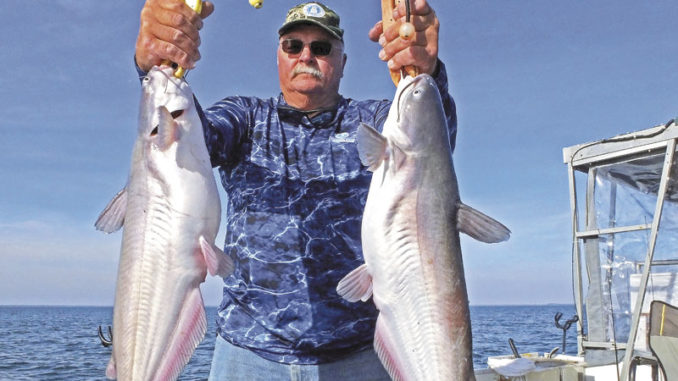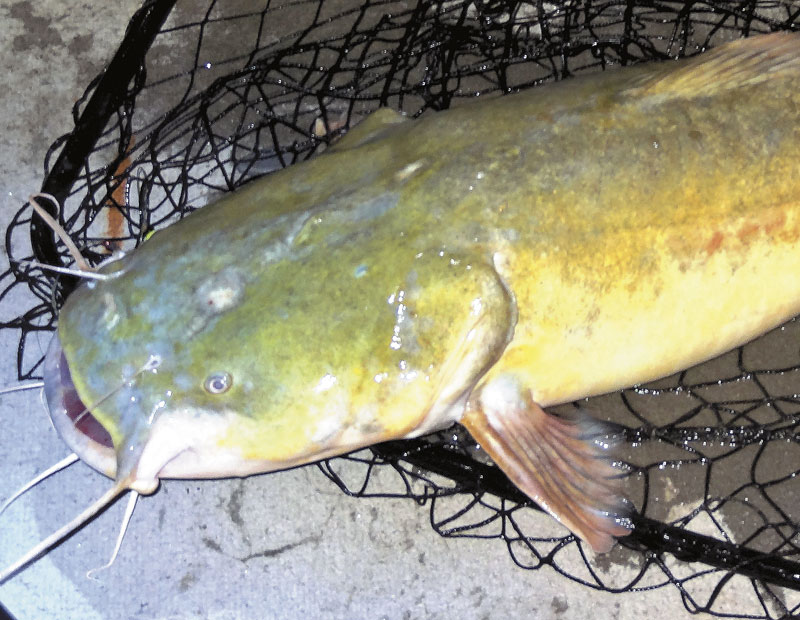
Head to the shallows for hot catfish action this month
April is a prime month for shallow water fishing action at Santee Cooper and this skinny water holds some really “fat cats.” As multiple species of smaller fish flood into the Santee Cooper shallows, big blue and flathead catfish follow.
Skinny Water Hotspots
Scott Cole is a USCG licensed fishing guide out of Blacks Camp with 30 years of experience chasing big catfish on lakes Marion and Moultrie.
“I love April catfishing because it’s big-fish time in shallow water,” Cole said. “We catch big fish year-round. But during April and May, trophy catfish get into shallow water in big numbers. And it’s prime time to get your string stretched by a huge catfish.”
Cole (704-472-4450) said the overall key to fishing success is shallow water, often back in the flats in and around cypress trees.
“I like to have some slightly deeper water nearby,” he said. “The proximity of deeper water provides more consistent fishing action. Even the slight depth difference attracts the biggest catfish better than anchoring in the back end of a long, shallow flat with the same depth of water everywhere.
“My favorite scenario is to fish a 3- to 4-foot hole or stretch of water surrounded by a 2-foot deep flat,” he said. “The site could be an old pond location inundated by the lake or a deeper ditch coursing through the flat. The ditch serves as a perfect funnel, to use deer hunting vernacular. These catfish roam the shallow water seeking the abundant forage available at this time of the year,”
Skinny setup
Unlike when pursuing cats in the open, deeper water where he’ll drift fish, Cole said it’s much more productive to anchor fish in the shallows.
“I use the ‘poor man’s power-poles’ to anchor my boat,” he said. “I have long poles that I run through pole holders of a slightly larger diameter placed around my pontoon boat. And I bury the poles into the bottom substrate and this eliminates swaying of the boat from wind or wakes from passing boats.”
Cole said fish are caught by day but he prefers to fish at night because bigger fish are more likely to be caught. He’ll leave Blacks Camp early enough to set up at his first location prior to dark.
“Both lakes Marion or Moultrie are excellent choices. I’ve got plenty of proven places in both lakes for big fish,” he said. “The key is usually the weather. If the weather pattern favors one lake or location that’s where I’ll go. A recent, strong bite in a particular area is always a good bet. But remember, these localized hot spots can change regularly.”
“Sometimes we’ll get a good flurry of action right at dusk. But generally once it gets dark, we’ll begin to pick up larger fish,” he said. “April, shallow water and darkness are a three-point recipe for big fish success.”
Cole uses multiple rods, depending on the number of anglers on the boat. But typically he’ll employ at least 8 rigs. He’ll fan cast them around the boat to cover as much water as possible.
“I’m usually within casting distance of some cypress trees and I’ll cast at least a couple of the rigs right up against the roots of those trees,” he said. “Big cats will be around those places looking for bream, shad or perch — anything they can eat.”

Baits and Mobility
Cole said blue catfish are most commonly caught but flatheads are taken too, more often at night. He uses an assortment of bait types until he patterns what the fish want, with bream, perch, shad and mullet all on the basic menu.
“Sometimes they all produce, sometimes one will be the flavor of the trip so I’ll bring plenty of each,” he said. “But anything these fish may already be eating in the shallows is a good bet.”
Cole moves to different locations if he’s not getting bites. He’ll fish an area a minimum of an hour at night, usually more.
“When I find catfish on a good bite, hopefully at the first place we stop, I’ll stay until the action slows,” he said. “If we catch three or four good-sized catfish from that spot and then the bite slows, my confidence level will be high and I’ll give that place another hour. I’ve seen the action wane and then another burst of big catfish action occurs. Big cats are on the prowl so patience is a real asset.
“If fishing action slows, I won’t hesitate to pick up and hunt for big fish,” he said. “A good bite is happening somewhere and my goal is to be a part of that action.”





Be the first to comment